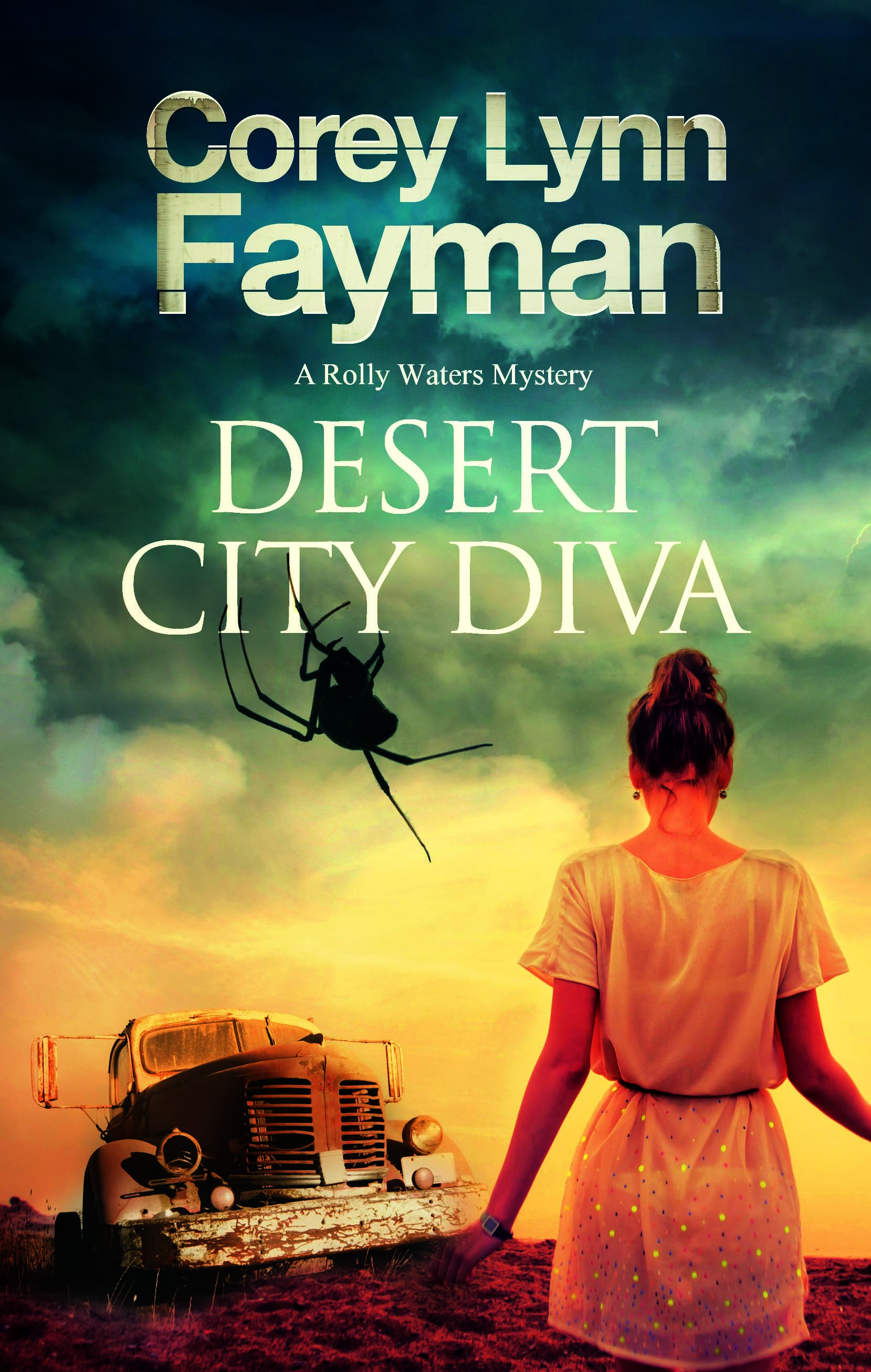 Desert City Diva by Corey Lynn Fayman
Desert City Diva by Corey Lynn Fayman
ISBN: 9780727885487
Severn House Publishers, January 2016
$28.95
www.coreylynnfayman.com
www.amazon.com
www.servernhouse.com
Frequently Asked Questions
- Desert City Diva is your third Rolly Waters mystery. What can you tell us about Rolly and how does this book continue the traditions established by the other novels in the series?
Rolly Waters is a cozy mystery hero living in a crime noir world. He’s overweight, over forty, and lives in a small granny flat next door to his mother. He’s a talented guitar player and musician whose glory days are behind him, so he makes ends meet by working part-time as a private investigator. He doesn’t carry a gun and would probably shoot himself in the foot if he had one. His chief virtues as an investigator are his ability to make friends with almost anyone and an absolute dedication to helping his clients, even when their cases lead him into dangerous situations and criminal activity he never envisioned when he first took it on.
Music has always been a part of all the Rolly Waters mystery novels, but in Desert City Diva it’s become central to solving the case. A special musical instrument and the ‘celestial’ notes it plays are keys to the mystery. It’s the first time Rolly’s had to call on both his musical and investigative skills to solve a case.
- In Desert City Diva, Rolly takes on a missing person’s case from a golden-eyed orphan and dance-club DJ named Macy Starr. What’s special about Macy and why is the search for the woman who raised her so important to her?
Macy is a willful and independent young woman who’s worked hard to create her own sense of identity. She’s never known her biological parents. She grew up as the daughter of the chief of police on an Indian reservation, but she’s not Native American. She knows nothing of her parents, or where she came from, except that she has some sort of ‘golden child’ status with her adoptive father. That didn’t help much on the reservation she grew up on though, where she was viewed as a bit of a freak. She’s taken that outsider view to heart in her professional life and created different DJ personas she uses to express herself.
Macy is almost completely lacking in impulse control in both her speech and actions. Whatever comes into her head, she says it or acts on it. Rolly finds this attractive. It’s how he used to be. But it frustrates him too, and he knows from experience it can lead to all sorts of trouble.
- The only clues Macy can provide Rolly are a curious one-stringed guitar called a Diddley Bow and a black and white photograph of a young girl with a man in a baseball uniform. What is the significance of these items, and why did you choose the Diddley Bow as the key to solving the mystery surrounding Macy’s case?
I can’t remember exactly where I learned about the Diddley Bow, but I used it in the story because it’s a simple instrument that non-musicians can pick up pretty quickly to thump out some basic melodies. It’s important to the story because I needed an instrument that the members of a UFO cult could all play together simultaneously. They use the Diddley Bows to play alternate tunings of ‘celestial’ notes that will reflect their ancient heritage and serve as a beacon to interplanetary aliens. I didn’t make that part up. There are people out there who believe this stuff. Search the Internet for information on the Solfeggio Harmonies.
The Diddley Bow is a real musical instrument. It’s a primitive one-stringed guitar that was first developed by sharecroppers in the American South, who were trying to recreate instruments they knew from Africa. The instrument interests Rolly because he’s a Blues aficionado, and Diddley Bows were one of the first instruments used in the development of Blues music.
The photograph laminated to the back of Macy’s Diddley Bow is the only connection she may have to her biological parents. She knows the woman is her Aunt Betty, who disappeared many years earlier and may or may not be her real aunt. Macy doesn’t know who the baseball player is, but Rolly recognizes him at once as a famous major-leaguer and local celebrity.
- Desert City Diva takes place on an Indian reservation in an area near the Anza Borrego Desert. How integral is this setting to this particular Rolly Waters mystery and why did you place the story in this environment?
We have quite a few Indian reservations in San Diego County. They are much smaller than the Navajo or Hopi reservations of Arizona, but they are true reservations, and as such they are independent sovereign entities with their own government and a police force just like the larger reservations. Many of them are located in the mountains of east San Diego County, which is still largely rural, and the kind of area where UFO cults might develop without attracting much attention. Legal and criminal issues can get complicated, as county sheriffs do not have authority on reservation lands and vice-versa. Many of the tribes have built casinos now, and that provides some tension related to the character’s motivations, as well.
- Can you describe some of the research you did when you were writing Desert City Diva?
My last two novels were inspired by fortuitous driving adventures with my wife. In the case of Desert City Diva, the drive took place in the southern desert of California where we happened upon two places with rather interesting names – Salvation Mountain and Slab City. The first turned out to be a remarkable monument to one man’s religious passions, and the second is an off-the-grid gathering of hippies, retirees and social misfits who have chosen to live together in an ad hoc desert community where they resist both the comforts and confines of modern society. Most of the residents live in trailers or RVs, which are parked on slab foundations left over from a U.S. Army fort used in WWII. Slab City residents have a library, a café, a modern sculpture garden, and a stage where they hold musical jam sessions every week. Once I found out about those jam sessions, I knew I had to get Rolly Waters out there to play his guitar.
The other thing I did some research on was the concept of sacred harmonies and the use of alternate musical scales, much of which is quite interesting and some of which is quite silly. There was also a bit of San Diego history I had to look into, such as the mini-gold rush in our mountains in the 1870s, as well as local Indian reservations and their history. San Diego County was where the Heaven’s Gate mass suicide took place in 1997, so I did quite a bit of research on that and other suicide cults, to help me understand how something like that can happen.
- Are you working on another Rolly Waters mystery? If so, what can you tell us about it?
I’ve sent Rolly to the far edges of San Diego County in my last two books, so I’ve decided to bring him back home for his next adventure. Most of the action takes place in and around San Diego Bay. The jumping off point is the very real U.S. Navy Marine Mammal Program, which has trained captive dolphins and sea lions to perform tasks such as mine identification, sea floor retrieval and enemy diver detection. The story centers on a Navy diver whose body was never recovered after a training accident twenty years earlier, but who seems to be taking revenge in the present day on some of the people who knew him. It also works in some of the recent controversy surrounding sea mammal captivity at Sea World and other animal water parks. The working title is Ballast Point Breakdown.

